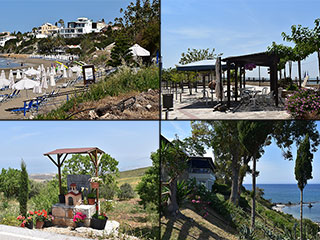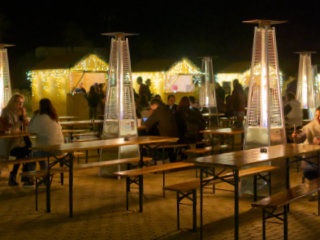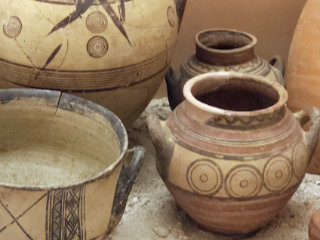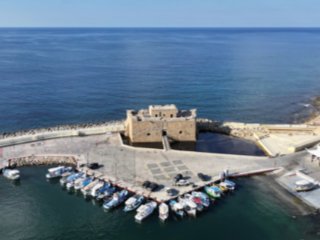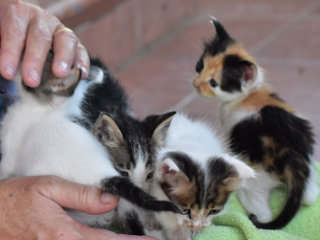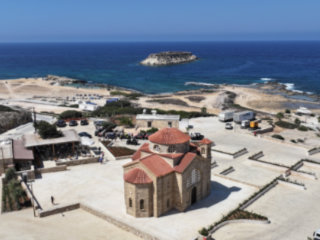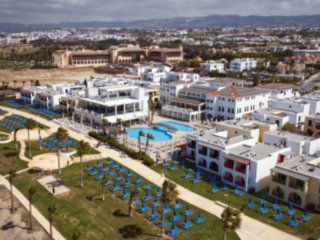The House of Dionysus
Icarios
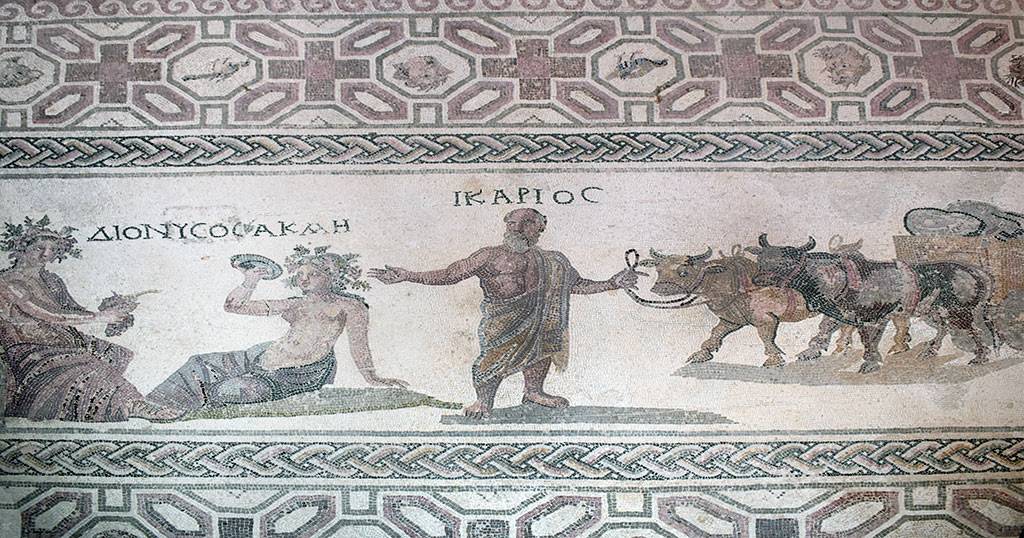
The second panel represents the story of Icarios. Dionysos and the half-naked Acme are depicted to the left of the panel. In the centre, Icarios is seen holding the reins of an ox-driven double wheeled cart, filled with sacks of wine. Further to the right, there are two shepherds in a state of inebriation. A sign identifies them as “the First Wine Drinkers”.
Icarius was cordial towards Dionysus, who gave his shepherds wine. The shepherds became intoxicated and killed Icarius, thinking he had poisoned them. His daughter, Erigone, and her dog, Maera, found his body. Erigone hanged herself over her father's grave. Dionysus was angry and punished Athens with a plague, inflicting insanity on all the unmarried women, who all hanged themselves like Erigone did. The plague did not cease until the Athenians introduced honorific rites for Icarius and Erigone. Icarius was placed in the stars as the constellation Boötes.
Source: wikipedia
Poseidon and Amymone
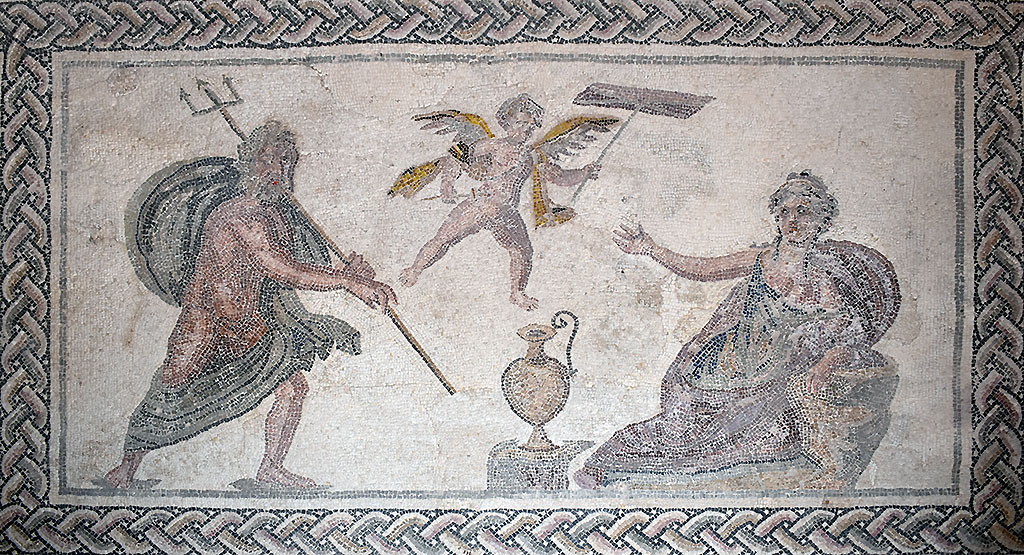
The third panel represents the myth of Poseidon and Amymone. An Eros is depicted between them.
Amymone and Poseidon
Amymone and Poseidon are one of the less known couples of the ancient Greek mythology. Poseidon, god of the sea, earthquakes and horses was, as we all know, happily married to Amphitrite, but, like all gods, had an occasional affair every once in a while.
Amymone was one of the daughters of King Danaos, which meant that she was a Danaid, and also that she had 49 sisters at home. The funny thing about Danaos having 50 daughters is that his twin brother, Aigyptos, had 50 sons. Long story short, Aigyptos wanted his sons to marry their cousins, Danaos didn't, so he took his girls and fled.
Danaos and his daughters found shelter in Argos, where the people had only good intentions, but were in serious trouble, because the entire region was dried up. That severe drought was Poseidon's doing. He and Hera competed for the supremacy over the new city, and Hera won. Poseidon decided to avenge his wounded ego by making the locals die of thirst.
The newcomers tried their best to help, and all the 50 daughters of Danaos went in search of water. Amymone went deep into a forest, hoping to find a spring, but instead, she stumbled upon a satyr, who was instantly charmed by her looks and attempted to rape her. Amymone's cries and shouts attracted the attention of Poseidon, who saved her from the satyr and kept her for himself. Before letting her go, he showed her the location of the springs of Lerna, so the region was saved.
Amymone and Poseidon had a child together (that's generally the whole point of these stories when a god mates with a mortal) named Nauplios, who was the grandfather of one of the Argonauts. Amymone did eventually marry her cousin, specifically the one named Lynceus – and was the only one to do so, as her 49 sisters killed their 49 husbands on the wedding night, but that's a different story. The children Amymone had with Lynceus started a long line of kings, which would culminate with Danae and her famous son, Perseus. Don't you just love how everybody is related to everybody? Just like a soap opera.
Source: ancientlinks
Apollo and Daphne
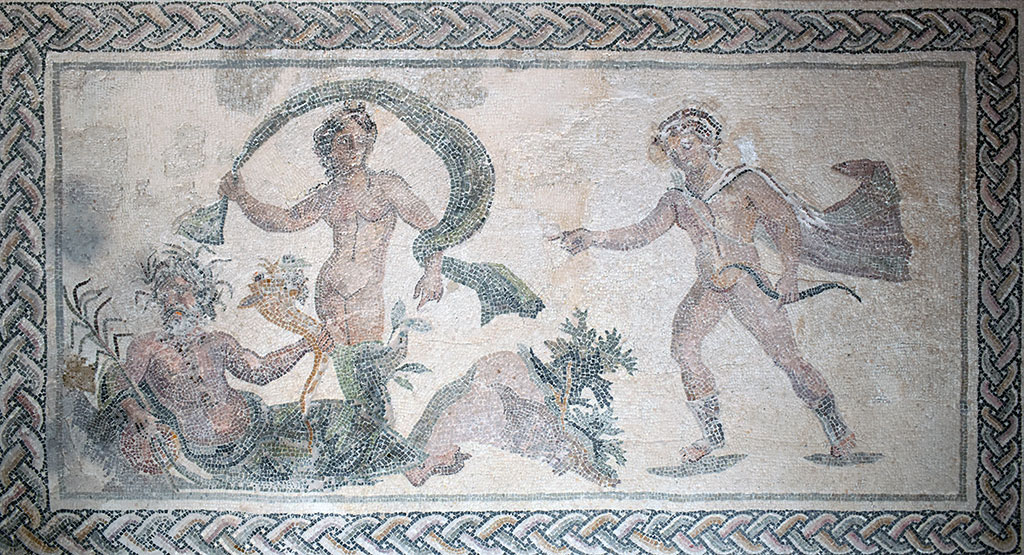
The fourth panel represents the mythological love of Apollo for Daphne and her transformation into a laurel tree by her father Peneus.
Apollo, the Greek/Roman god of music, poetry, art, the sun and a great warrior, mocked the god of love, Eros (Cupid), for his use of bow and arrow, as Apollo is also patron of archery. “What are you doing with powerful weapons, naughty boy?” he said. "That equipment of yours is fitting of our shoulders, which are able to give certain wounds to wild animals, and to enemies, I who recently killed the swollen Python, who was pressing down so many acres with his disease-bearing belly, with countless arrows! You will be content to provoke some loves by your fire, not to lay claim to my honors.” This is the context behind the story.
The insulted Eros then prepared two arrows: one of gold and one of lead. He shot Apollo with the gold arrow, instilling in the god a passionate love for the river nymph Daphne. He shot Daphne with the lead arrow, instilling in her a hatred for Apollo. Having taken after Apollo’s sister, Artemis (Diana), Daphne had spurned her many potential lovers, preferring instead woodland sports and exploring the forest. Due to her identity as an “aemula Phoebes” (female rival or emulator of Artemis), she had dedicated herself to perpetual virginity. Her father, the river god Peneus, demanded that she get married and give him grandchildren. She, however, begged her father to let her remain unmarried; he eventually complied.
Apollo continually followed her, begging her to stay, but the nymph continued to reject him. They were evenly matched in the race until Eros intervened, helping Apollo catch up to Daphne. Seeing that Apollo was bound to reach her, she called upon her father, "Help me, Peneus! Open the earth to enclose me, or change my form, which has brought me into this danger! Let me be free of this man from this moment forward!" And with that, Peneus answered her plea and “a heavy numbness seizes her limbs; her soft breasts are surrounded by a thin bark, her hair changes into foliage, her arms change into branches; her foot, just now swift, now clings to sluggish roots.” She turned into a laurel tree.
In spite of Daphne's terror and fervent insistence that he leave her alone, Apollo vowed to honor her forever: “Always my hair will have you, my lyres will have you, my quivers will have you, laurel tree. You will be present for the Latin leaders when a happy voice will sing a triumph and the Capitoline Hill will see long processions.”
Apollo also used his powers of eternal youth and immortality to render Daphne evergreen ("you also, wear always the perpetual honors of your foliage!"). For this reason, the leaves of the Bay laurel tree do not decay.
Source: wikipedia
The Impluvium
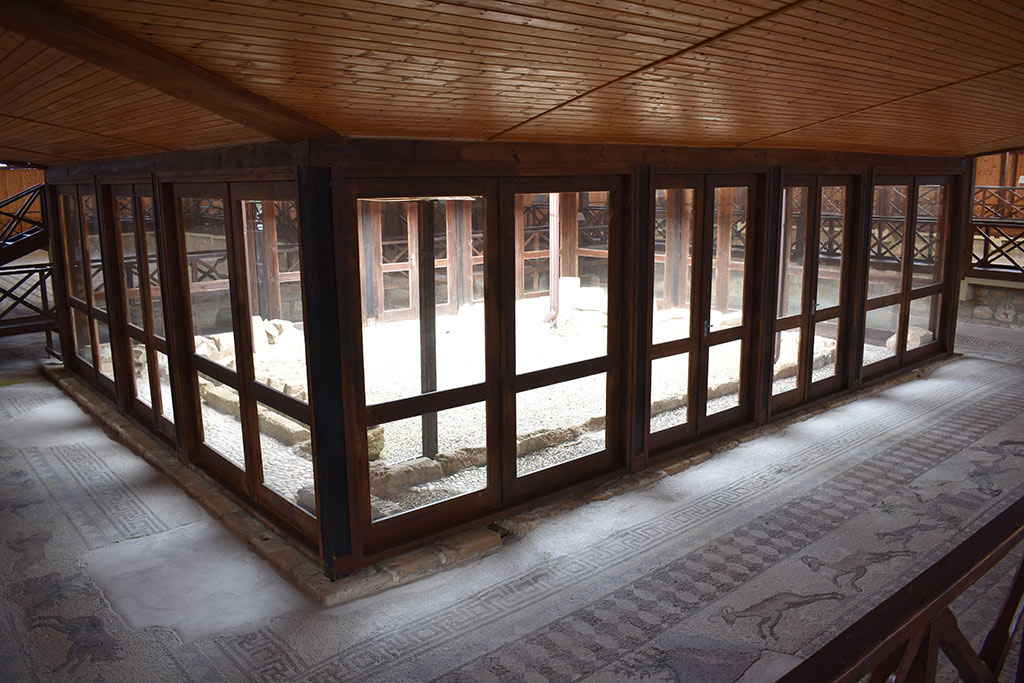
The impluvium is the sunken part of the atrium in a Greek or Roman house (domus). Designed to carry away the rainwater coming through the compluvium of the roof, it is usually made of marble and placed about 30 cm below the floor of the atrium.
Inspection (without excavation) of impluvia in Paestum, Pompeii and Rome by an American civil engineer indicated that the pavement surface in the impluvia was porous, or that the non-porous stone tiles were separated by gaps significant enough to allow a substantial quantity of water caught in the basin of the impluvium to filter through the cracks and, beyond, through layers of gravel and sand into a holding chamber below ground. The circular stone opening (visible in the photograph, resembling a chimney pot) allows easy access by bucket and rope to this private, filtered and naturally cooled water supply.
Similar water supplies were found elsewhere in the public spaces of the city with their stone caps showing the wear patterns of much use (the rope wear patterns also are visible in the photograph). In wet seasons, excess water that could not pass through the filter would overflow the basin and exit the building, and any sediment or debris remaining in the surface basin could be swept away. In hot weather, water can be drawn from the cistern chamber (or fetched by slaves from supplies outside the domus) and cast into the shallow pool to evaporate and provide a cooling effect to the entire atrium. As the water evaporates, the surrounding air is cooled and becomes heavier and flows into the living spaces and is replaced by air drawn through the compluvium. The combination of the compluvium and impluvium formed an ingenious, effective and attractive manner of collecting, filtering and cooling rainwater and making it available for household use as well as providing cooling of the living spaces.
Source: wikipedia
The above article is well worth a read as it contains a diagram of a typical Roman house so you can get a better feel as to how the rooms are interlinked and complement each other.
Onwards We Go
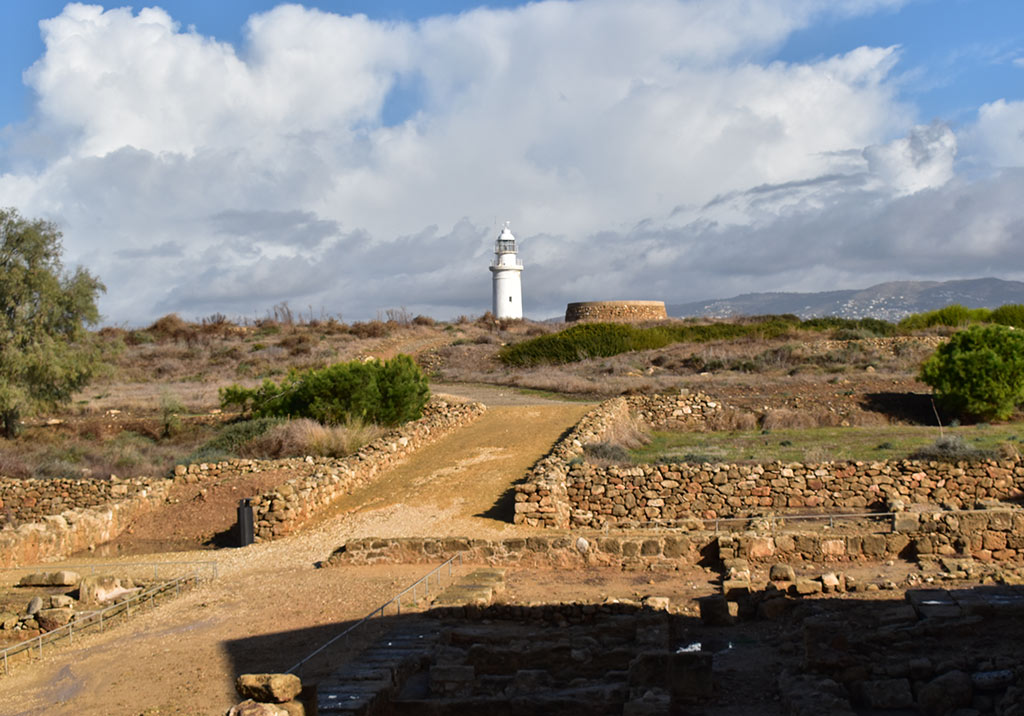
Step outside of the shelter, and you can see you are surrounded by more ruins. How many of these rooms contain decorative mosaics, waiting to be uncovered? Time will tell. For now though, we are heading up towards the lighthouse, as you shall see in our next blog...
Page 7 of 7


Related Blogs:
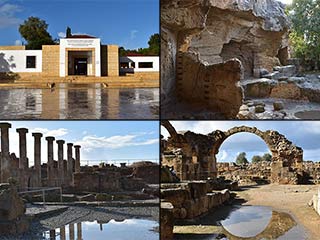
Paphos Archaeological Park - Summary
We first blogged about the Archaeological Park a couple of years ago. It was a short blog, and focused mainly on the pretty spring flowers. Now we are returning, to give the rest of the park the attention it so richly deserves.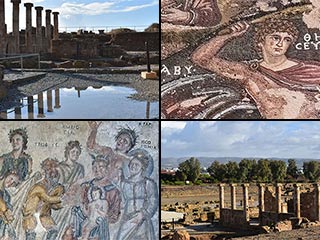
The Houses of Aion and Theseus
It's time now to start our detailled look at the Archaeological Park, so let's begin at the beginning. Once you enter the Archaeological Park, if you keep left, the first sites you will arrive at the The Houses of Theseus and Aion. Let's take a look at their mosaics and other attractions...Good Pages To Visit
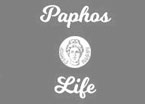
FB PagePaphos Life on Facebook
Like us on Facebook and stay notified of new blog posts.

FB PageOur Facebook Chat Group
Paphos Chat has been created for people who like our site and want to chat using Facebook. You can also easily upload photos of any size here. A lot of people are members of the Facebook chat group and the main forum. It's entirely up to you.
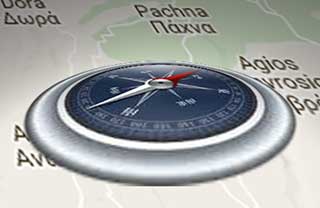
ListBlog Locations
Planning a day out? Then use our map of blog locations as a handy guide. Some of the places we visit our closer to each other than you might think, so take a look and start planning your next adventure...
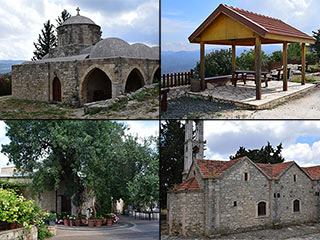
eBookCyprus Road Trip 01: the Kathikas - Panagia Loop
Let me take you on a journey around the region of Paphos, Cyprus. Starting at Paphos itself, we travel to Akoursos, then Kathikas, Kritou Terra and Simou. We continue past Lasa and Kannaviou, before taking in the delights of Panagia. Getting a bit more adventurous, we visit the abandoned villages of Statos and Agios Fotios, before passing through Choulou, Letymbou and Polemi, and rejoining the main Paphos - Polis road.
The route is suitable for all types of vehicle, and requires no off-roading. The guide contains about 130 photographs including shots of all the road signs you need to pay attention to, as well as some of the highlights you may experience along the way.
There are also several maps which will help you keep your bearings.
You can do this journey in a day, or you can break it up into chunks. You can also do it in reverse, to get some completely different views. It is entirely up to you.
